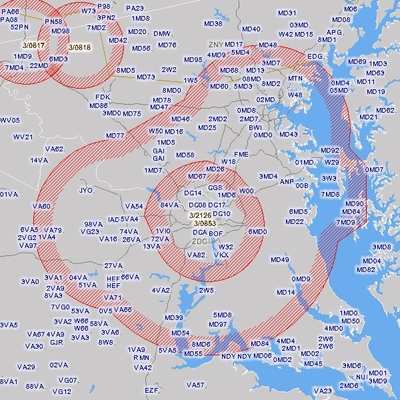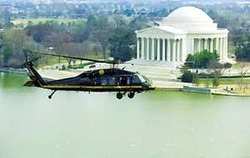Center Part Of Operation Noble Eagle
 Civilian and military dignitaries
cut the ribbon to officially open a modern operations center that
monitors the heavily traveled skies around the nation's capital
Feb. 3.
Civilian and military dignitaries
cut the ribbon to officially open a modern operations center that
monitors the heavily traveled skies around the nation's capital
Feb. 3.
The Joint Air Defense Operations Center, called "JADOC" for
short, is staffed around the clock at Bolling by Air Force and Army
National Guard personnel to watch for potentially dangerous
aircraft such as the hijacked jetliner that crashed into the
Pentagon on September 11, 2001.
The new compact facility is another sign Operation Noble Eagle
and other efforts to defend the nation during the global war on
terrorism will be around for a long time.
The operations center is the heart of a sophisticated
air-defense system that incorporates jet fighters and air-defense
artillery units on constant alert around the Washington area.
Dr. Jan Brecht-Clark, director for transportation and aviation
security with the White House Homeland Security Council; Air
National Guard Maj. Gen. Craig McKinley, commander of the 1st Air
Force based at Tyndall AFB, (FL); and New Mexico Army Guard Brig.
Gen. Jamie Fletcher cut a ceremonial red, white, blue and yellow
ribbon to demonstrate that the center is helping to defend America
and that many people are serving far from their homes.
A tenant organization on Bolling, the center has actually been
functioning since Dec. 15, officials explained, when it replaced
the tents in which the center was originally installed after the
terrorist attacks. The Washington JADOC has been operating around
the clock since Feb. 8, 2003.
"We know that the real work is now being done in a facility that
has a dry floor and heat and air conditioning and a roof that
doesn't leak. And that's not the way that the JADOC has always
worked," observed Lt. Gen. H. Steven Blum, chief of the National
Guard Bureau.
He paid tribute in his remarks to the many civilian agencies,
including the Secret Service, and U.S. and Canadian military
organizations that have joined forces to safeguard the North
American continent from further terrorist attacks.

"We will never forget it. We are not going to let it happen
again," vowed General McKinley, who oversees air-defense activities
for the entire country.
"Turf and who's in charge did not get in the way. The mission
was what came first, and you have accomplished the mission,"
General Blum said. "I think we're reaping the benefits of that
every single day that we don't have an aviation event in which we
have to use you."
 General Fletcher, who commands the
111th Air Defense Artillery Brigade based in Albuquerque, has
rotated about 500 citizen-soldiers through the JADOC since March
2003 when that Army Guard outfit assumed the mission from the 32nd
Army Air Missile Defense Command.
General Fletcher, who commands the
111th Air Defense Artillery Brigade based in Albuquerque, has
rotated about 500 citizen-soldiers through the JADOC since March
2003 when that Army Guard outfit assumed the mission from the 32nd
Army Air Missile Defense Command.
"The year has gone by very quickly," said General Fletcher, who
has also served as the area's deputy air-defense commander. "We've
been very fortunate in the way this system has been set up so we
could execute the mission."
Members of the New Mexico brigade have been supported by members
of the Mississippi Army Guard, and the Georgia and Puerto Rico Air
National Guards.
The New Mexico brigade will turn over their part of the
Washington area's air-defense mission to the Florida Army Guard
Feb. 10.
"This is probably the most complex and sensitive mission that an
air defender could conduct, whether in the air or on the ground,"
General Blum pointed out. "I'm immensely proud that the National
Guard has had such a big part."
ANN extends a special thanks to the author of this story,
USAF Master Sgt. Bob Haskell, National Guard Bureau.
 Classic Aero-TV: Active Winglets -- Tamarack Aerospace Partners with Cessna
Classic Aero-TV: Active Winglets -- Tamarack Aerospace Partners with Cessna Aero-News: Quote of the Day (05.03.25)
Aero-News: Quote of the Day (05.03.25) ANN's Daily Aero-Term (05.03.25): Taxi
ANN's Daily Aero-Term (05.03.25): Taxi ANN's Daily Aero-Linx (05.03.25)
ANN's Daily Aero-Linx (05.03.25) Airborne 05.02.25: Joby Crewed Milestone, Diamond Club, Canadian Pilot Insurance
Airborne 05.02.25: Joby Crewed Milestone, Diamond Club, Canadian Pilot Insurance





